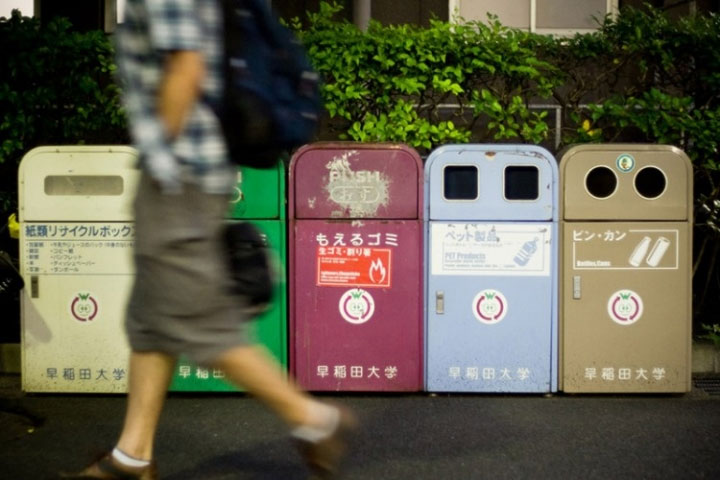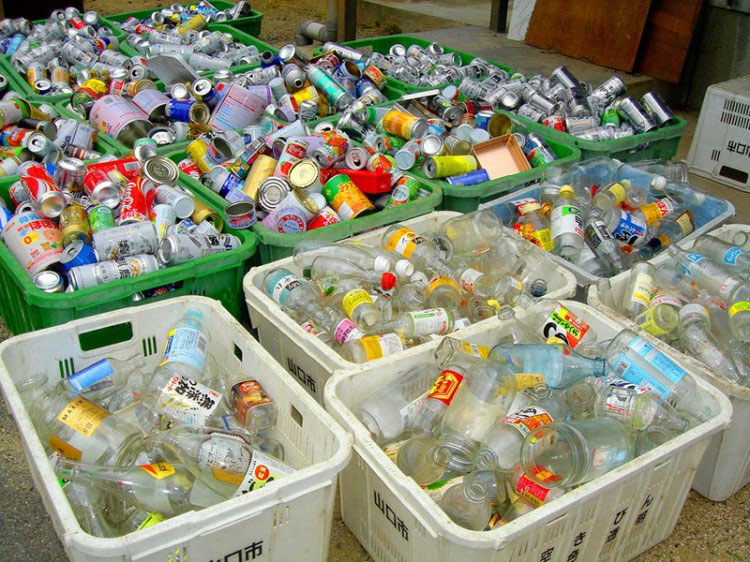How does Japan handle garbage security?
With over 45 million tons of waste per year, Japan successfully developed an efficient waste treatment system, becoming one of the cleanest countries in the world.
In Japan, the issue of waste disposal and garbage security is effectively implemented, thanks to the successful implementation of the waste separation system from the beginning and the application of modern waste recycling and treatment technology.
Garbage collection and sorting
Public trash in Japanese streets often consists of many adjacent bins, according to Tofugu. People in this country not only need to sort and clean up the garbage according to the instructions, but also make sure to dump the garbage on the right day and put the garbage in the right color. If done wrong, the garbage will be returned to the landlord.

Public trash in Japan.(Photo: Elmimmo).
Every city in Japan has a handbook about garbage disposal."Problems related to garbage can easily cause problems for neighbors. To create a comfortable life for both you and others in the community, you need to follow local regulations on garbage collection. " , Tokyo International Communications Council stressed.

Garbage is carefully sorted before being dumped.(Photo: Timothy Takemoto).
The Japanese waste classification system is relatively complicated. Each city, town and county has a completely different system. For example, 23 neighborhoods in Tokyo have their own waste sorting system, all burnable garbage is required to be placed in a red, unburnable bag in a blue bag while paper, plastic, bottles , soft plastic, newspaper, cover, glass and battery in white bag.
Burn the garbage
According to Waste Atlas, Japan discharges a total of 45.36 million tons of garbage each year, ranking 8th in the world. Because there is not much land to bury garbage like the US and China, Japan is forced to rely on another solution of burning garbage.

Inside a waste incineration plant by fluidized bed method.(Photo: Gea.com).
Get copies using fluidized bed burning, an effective method to burn hard-to-burn materials. Careful sorting of waste will be hung above the foaming hot ash cushion so that hot air flows through, which helps to transfer heat quickly and promote chemical reactions to take place.
The method of treating solid waste by heat is more beneficial than other forms of incineration such as cheap, less area, less nitrogen oxide (NO) and sulfur dioxide (SO 2 ), copper time to produce electricity from the heat generated during combustion. This technology helps Japan handle 69% of the total amount of waste every year, and is widely spread to other countries such as China, Thailand, and Singapore.
Recycling

PET bottles of soft drinks are very popular in Japan.(Photo: Wordpress).
20.8% of total annual waste is recycled by Japan, especially p olyethylene terephthalate (PET) plastic bottles. PET is a popular material for producing drinking water bottles in vending machines and grocery stores across Japan. Many Japanese companies are increasingly using plastic from old PET bottles for new production. PET bottles that have not undergone filtration can be converted into sewing thread, bags, carpets and raincoats.
Sea encroachment by rubbish to create more land

Kansai International Airport built on artificial islands filled with garbage.(Photo: Wikipedia).
Japan applies heavy rock filler technology, cement, dust and garbage to create new land. Both international airports are Chūbu Centrair (near Nagoya) and Kansai are built on artificial islands filled with garbage. In Tokyo, the city government renovated 249 km2 of land along Tokyo Bay by landfills.
- 'Big family' technology helps to handle Japan disaster
- Japan makes a net to clean garbage in space
- Japan will have the world's first zero-waste city
- Japan set a net to clean up the unsuccessful space garbage
- Video: The project to manufacture space hook TB to remove garbage in space
- America - Japan cooperates to monitor pillar garbage
- Millions of tons of garbage drifted from Japan to the United States
- Garbage after tsunami in Japan drifted to America
- Japan intends to clean up cosmic garbage with lasers
- Japan has a net to clean up garbage
- Japan established a space monitoring force
- Patrol robot with security guard
 Is the magnetic North Pole shift dangerous to humanity?
Is the magnetic North Pole shift dangerous to humanity? Washington legalizes the recycling of human bodies into fertilizer
Washington legalizes the recycling of human bodies into fertilizer Lightning stone - the mysterious guest
Lightning stone - the mysterious guest Stunned by the mysterious sunset, strange appearance
Stunned by the mysterious sunset, strange appearance